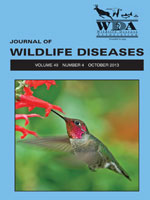Limited information exists on Neospora caninum transmission dynamics in wildlife. This coccidian parasite, whose presence can lead to substantial economic losses in cattle operations, requires a canid definitive host for reproduction. We examined exposure in a definitive host, coyotes (Canis latrans), and in overlapping populations of feral swine (Sus scrofa) to determine if spatial proximity between a definitive and incidental host influences the likelihood of parasite exposure. Eighteen percent of coyotes (95% confidence interval [CI] = 14.2–21.8) and 15.8% of feral swine (95% CI = 12.5–19.2) had been exposed to N. caninum, and this is the first report of exposure in US feral swine populations. Analyses suggest that the parasite is present throughout the environment and that exposure is not temporally or spatially linked to antibody-positive coyotes. Antibody-positive feral swine were found in an area where the only definitive host is domestic dogs (Canis familiaris), indicating that wild canids are not required to maintain the parasite in the environment.
How to translate text using browser tools
1 October 2013
Neospora caninum Exposure in Overlapping Populations of Coyotes (Canis latrans) and Feral Swine (Sus scrofa)
Sarah Bevins,
Emily Blizzard,
Luis Bazan,
Pat Whitley
ACCESS THE FULL ARTICLE

Journal of Wildlife Diseases
Vol. 49 • No. 4
October 2013
Vol. 49 • No. 4
October 2013
canine
coccidian
feral swine
Neospora
surveillance




